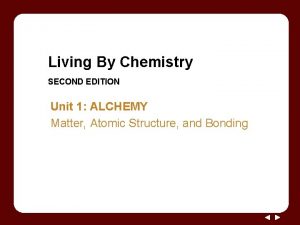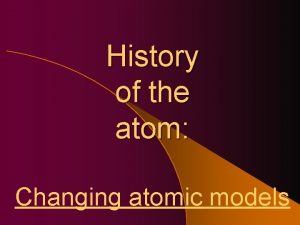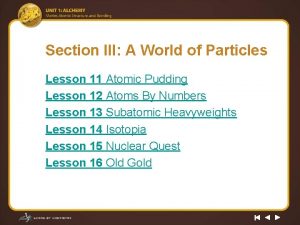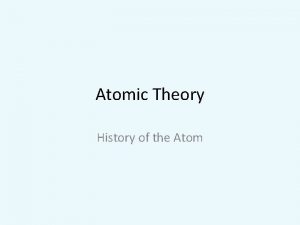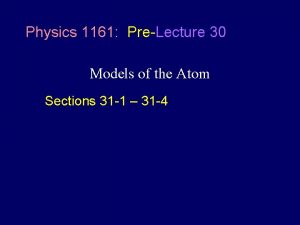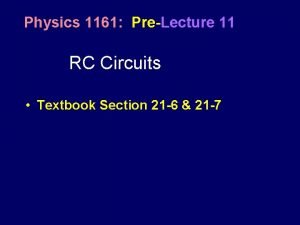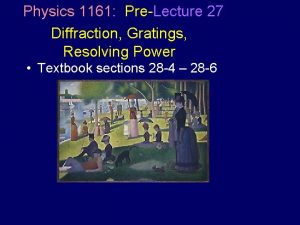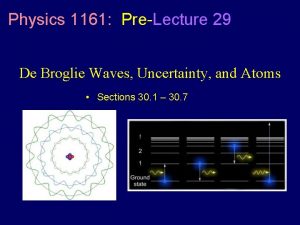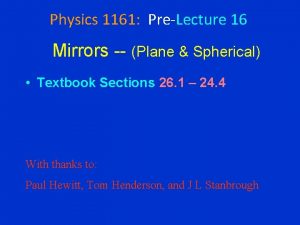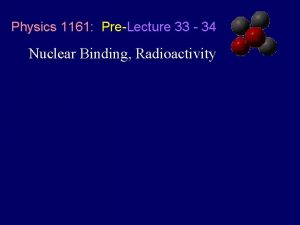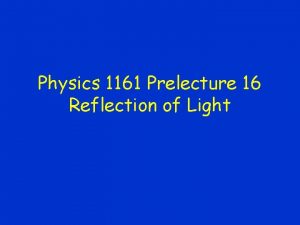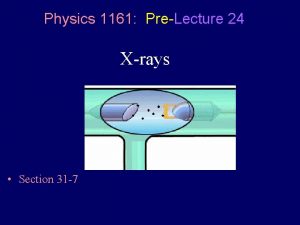Physics 1161 PreLecture 23 Models of the Atom














- Slides: 14

Physics 1161: Pre-Lecture 23 Models of the Atom Sections 31 -1 – 31 -4

The Bohr Model What works, approximately Hydrogen-like energy levels (relative to a free electron that wanders off): Typical hydrogen-like radius (1 electron, Z protons):

Transitions + Energy Conservation • Each orbit has a specific energy: En= -13. 6 Z 2/n 2 • Photon emitted when electron jumps from high energy to low energy orbit. Photon absorbed when electron jumps from low energy to high energy: | E 1 – E 2 | = h f = h c / l

Line Spectra In addition to the continuous blackbody spectrum, elements emit a discrete set of wavelengths which show up as lines in a diffraction grating. This is how neon signs work! Which lamp is Hydrogen? Better yet… Wavelengths can be predicted!

Spectral Line Wavelengths Calculate the wavelength of photon emitted when an electron in the hydrogen atom drops from the n=2 state to the ground state (n=1). n=3 n=2 n=1

Spectral Line Wavelengths Calculate the wavelength of photon emitted when an electron in the hydrogen atom drops from the n=2 state to the ground state (n=1). E 2= -3. 4 e. V E 1= -13. 6 e. V n=3 n=2 n=1

Quantum Mechanics • Predicts available energy states agreeing with Bohr. • Don’t have definite electron position, only a probability function. • Orbitals can have 0 angular momentum! • Each electron state labeled by 4 numbers: n = principal quantum number (1, 2, 3, …) l = angular momentum (0, 1, 2, … n-1) ml = component of l (-l < ml < l) ms = spin (-½ , +½)

Summary • Bohr’s Model gives accurate values for electron energy levels. . . • But Quantum Mechanics is needed to describe electrons in atom. • Electrons jump between states by emitting or absorbing photons of the appropriate energy. • Each state has specific energy and is labeled by 4 quantum numbers (next time).

JAVA Links • Bohr Atom • Debroglie Atom • Schroedinger Atom

Bohr’s Model • Mini Universe • Coulomb attraction produces centripetal acceleration. – This gives energy for each allowed radius. • Spectra tells you which radii orbits are allowed. – Fits show this is equivalent to constraining angular momentum L = mvr = n h

Bohr’s Derivation 1 Circular motion Total energy Quantization of angular momentum:

Bohr’s Derivation 2 Use in “Bohr radius” Substitute for rn in Note: rn has Z En has Z 2

So Why is Bohr Wrong? • Bohr gets energy levels correct, and also approximate size. • Quantized electron velocity and radius violates Heisenberg uncertainty principle. • It is “LUCKY” that Bohr model got anything correct!

Let’s try it! The smaller space you try to confine a particle, the more energy it takes. – Small space => small D x – Small Dx => large Dp – Large Dp => large KE. . . • Electric Potential Energy • Electron’s Kinetic Energy Note: and Substitute into KE formula: R (nm) U (e. V) KE. 0053. 53 U+KE -27. 2 +13. 6 -13. 6
 The structure of the atom section 2 defining the atom
The structure of the atom section 2 defining the atom Perkembangan model atom rutherford
Perkembangan model atom rutherford Atomic theory models timeline
Atomic theory models timeline Lesson 11 atomic pudding models of the atom answer key
Lesson 11 atomic pudding models of the atom answer key Atom models history
Atom models history Lesson 11 atomic pudding models of the atom
Lesson 11 atomic pudding models of the atom History of atomic model
History of atomic model Difference between models and semi modals
Difference between models and semi modals Ia physics examples
Ia physics examples Modern physics vs classical physics
Modern physics vs classical physics University physics with modern physics fifteenth edition
University physics with modern physics fifteenth edition Một số thể thơ truyền thống
Một số thể thơ truyền thống Biện pháp chống mỏi cơ
Biện pháp chống mỏi cơ Trời xanh đây là của chúng ta thể thơ
Trời xanh đây là của chúng ta thể thơ Chó sói
Chó sói



